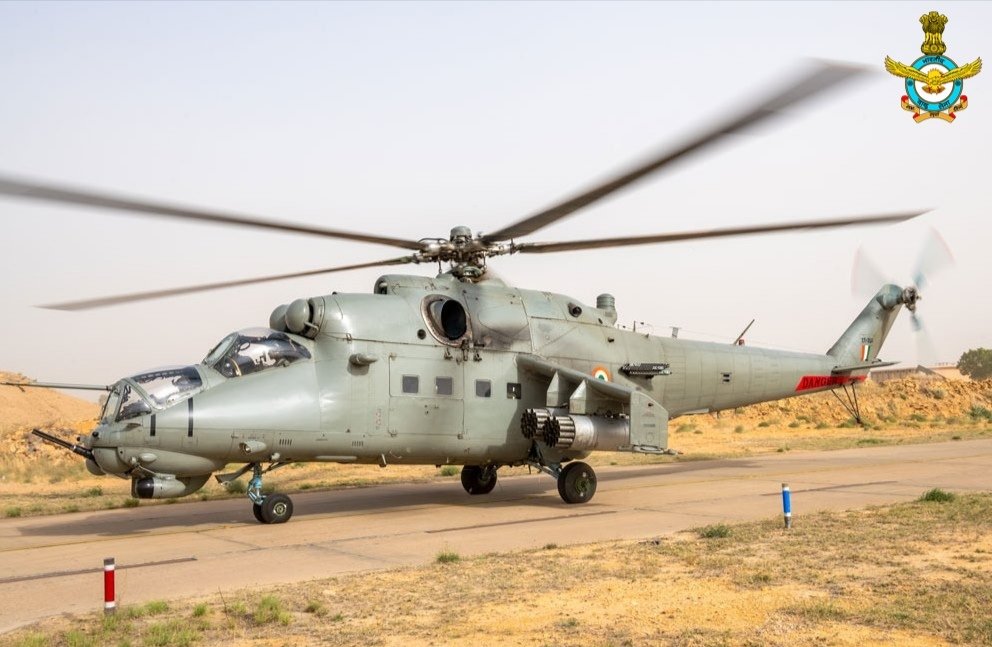SOURCE: RAUNAK KUNDE / NEWS BEAT / IDRW.ORG


The Indian Air Force (IAF) is charting a new course for its attack helicopter fleet, with plans to retire its ageing Mi-35 Hind helicopters by the 2030s. Currently, the IAF operates a single squadron of these Soviet-era gunships, which are undergoing a comprehensive overhaul to extend their service life until the end of the decade.
Speaking to idrw.org, an IAF official confirmed that the Mi-35 will be replaced by the indigenously developed Light Combat Helicopter (LCH) Prachand, despite the two platforms belonging to different weight and capability classes.
Introduced in the 1980s, the Mi-35 Hind has been a workhorse for the IAF, providing close air support and anti-armor capabilities in various operations. However, with the fleet nearing the end of its operational lifespan, the IAF is shifting its focus to modern, homegrown solutions. The LCH-Prachand, designed by Hindustan Aeronautics Limited (HAL), is poised to take over not only from the Mi-35 but also to become the backbone of the IAF’s attack helicopter fleet in the coming years.
In a significant strategic pivot, the IAF has also shelved plans to procure additional Boeing AH-64E Apache helicopters, which it currently operates in limited numbers. The decision underscores the force’s confidence in the LCH-Prachand to meet its diverse operational requirements, ranging from high-altitude missions to ground support in conventional theatres. “The LCH-Prachand will not just replace the Mi-35 but will emerge as the largest attack helicopter fleet type in our inventory soon,” the official told idrw.org, signalling a major endorsement of India’s indigenous defence capabilities.
The LCH-Prachand, unlike the heavier Mi-35, is a light attack helicopter optimized for agility and versatility. With a maximum takeoff weight of 5.8 tons compared to the Mi-35’s 11.5 tons, the Prachand is tailored for operations in India’s challenging terrains, particularly the high-altitude regions of Ladakh and the Himalayas. It boasts a unique ability to operate at altitudes up to 6,500 meters (21,300 feet), a capability demonstrated during trials in Ladakh—a feat the Mi-35 struggles to match. Armed with air-to-air and air-to-ground missiles, a 20mm turret gun, and rocket pods, the Prachand offers a potent mix of firepower and manoeuvrability.
While the Mi-35 is a heavily armoured gunship designed for direct combat and troop support, the LCH-Prachand compensates with stealth features, advanced avionics, and a focus on precision strikes. The IAF’s decision to transition to this lighter platform reflects a shift in operational philosophy, prioritizing flexibility and indigenous technology over the brute force of legacy systems like the Mi-35 or the Apache.
The IAF currently operates 22 AH-64E Apaches, inducted between 2019 and 2021, but has opted against expanding this fleet further. Instead, it is doubling down on the LCH-Prachand, with an initial order of 15 units already in place (10 for the IAF and 5 for the Indian Army under a Limited Series Production batch). A larger order of 156 additional LCH units—114 for the Army and 42 for the IAF—is in the pipeline, pending final approval. This ambitious procurement plan highlights the IAF’s intent to build a formidable fleet of Prachands, potentially exceeding the combined numbers of Mi-35s and Apaches in service.
The overhaul of the Mi-35 fleet, undertaken with Russian assistance, will ensure it remains operational until the 2030s, providing a buffer as the LCH-Prachand is inducted in greater numbers. However, the Mi-35’s retirement will mark the end of an era for the IAF, which has relied on Soviet and Russian helicopters for decades.
NOTE: Article cannot be reproduced without written permission of idrw.org in any form even for YouTube Videos to avoid Copy right strikes. Websites doing illegal reproductions will get DMCA and Legal Notices.